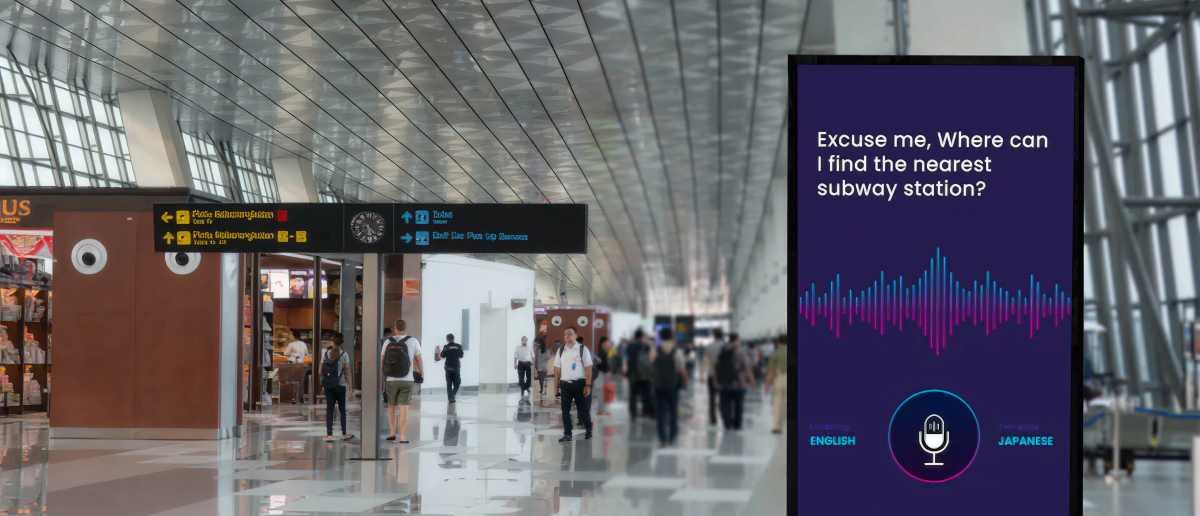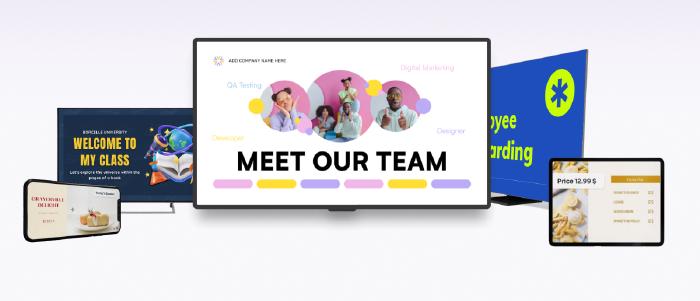
Nov 26 2025
7 min read

The last decade has given rise to a transformative digital technology revolution within travel and tourism.
Today’s tourists expect more than a stationary sign or printed map; they want interactive, dynamic and responsive travel product solutions that provide a seamless travel experience that delightfully changes the exploration of a destination.
In this blog, we’ll explore why voice enabled digital signage is essential for tourists. Whether they are travelling independently or part of a special interest tour group.
Digital Signage started with LED Displays and scrolling text panels to high-definition video walls, creating an interactive atmosphere.
Initially, Our Primary Goal was to share static information like directions, even schedulers or promotional content. Over time, touch screens made content interactive, which allows tourists to explore maps, book a ticket, or find a restaurant nearby.
Using the Murf AI voice Generator is the next logical step for this evolution.
It helps to improve voice recognition and response capabilities, and digital signage displays become conversational partners. It enhances usability but aligns with broader trends in smart cities and contactless interactions.

Voice-activated screens in tourist destinations are not only modern, but they also address practical problems of both the travellers and the operators. Here’s how they highlight the key benefits of digital signage in the tourism industry:
Diverse Tourist Accessibility
People travelling have diverse backgrounds and might have difficulty reading small print, deciphering complicated menus, as well as using touch-screens because of mobility or sight problems. The voice commands shatter such obstacles and allow everyone to acquire information with the help of voice commands without having to deal with a touch interface.
Fluid Multilingual Support
Language is one of the greatest challenges of tourism. Being voice-activated, the signage will be able to identify and answer in various languages and thus make the tourists feel at ease and familiar with the information being conveyed to them, no matter which language group they belong to. This is a multilingual ability that promotes inclusivity and a friendly atmosphere.
Hand Free Convenience Facility for the Travellers
Tourists usually travel with bags, gifts, or cameras, which is an impediment to interaction with touchscreens. They would be able to just ask questions through the voice-enabled signage, e.g. where is the nearest metro station? Or what is the closing time of the museum? Without any need to stop and leave things there.
Dynamic Information Delivery and Personalisation
Using voice systems, it is possible to provide personal recommendations according to the interests of visitors or in real-time. An example would be a tourist who inquires about restaurants located in the area. He or she may be recommended based on the type of food, proximity, or even on available offers. This degree of interactivity will make inactive screens active guides.
The feasibility of purposeful voice-enabled signage is a reality that has already begun to impact many tourist environments:
Airports: Large international airports are installing voice-enabled kiosks with airport digital signage to share gate infos, flight delays, and to indicate where facilities are located in multiple languages.
Museums and Heritage Sites: Visitors have a voice interactive guide responding to questions or providing historic context, or telling a story supported by museum digital signage without using physical hand-held audio devices.
City Centre and Transport Hubs: The tourism icons placed in city centres and transport hubs can feature voice-enabled screens with transportation digital signage to guide tourists on public transport, learn about attractions or even the current state of the weather.
Hotels and Resorts: Digital concierge with voice, enables the guests to enquire about the spa packages, local tours or a restaurant reservation, via the digital signage for hospitality placed in hotel lobbies.
These examples demonstrate both the adaptability of voice and its readiness to make adjustments to the situation and enhance the tourist experience throughout the whole process.
On the one hand, voice-enabled digital signage in tourism has its obvious benefits; on the other hand, however, its introduction will be associated with issues that should be addressed by the planners and operators alike:
Noisy Environments Performance: Tourist sites are noisy. In that case, to ensure that voice recognition systems already comprehend commands in that environment, advanced microphones and noise-cancelling features are necessary.
Privacy Concerns: The technology of collecting voice data also concerns the question of privacy and adherence to such processing rules as GDPR. Cleared data policies and safe systems are needed.
Cultural Sensitivity: The voice assistants should be coded so that they are able to understand a variety of accents and cultural variations, so that the response they give is only respectful and appropriate.
Maintenance and Update: Seeing that this is an online solution, these systems require regular updates, both to enhance recognition accuracy and to update content that can be used by the tourist.
With such considerations planned, destinations can be assured of keeping voice-enabled signages effective and trusted by the people.
In the future, voice-enabled digital signage will probably be integrated into larger systems of smart tourism. They might be connected to IoT (Internet of Things) devices to show real-time information about the presence of people in some locations, recommend less crowded pathways, or integrate mobile applications to plan a trip smoothly. To support this connectivity on the go, Europe eSIM will become essential for tourists relying on mobile apps and IoT integrations.
AI based digital signage can also personalise content on the basis of the communication of user and recommend according to the user. An example is when a visitor keeps on enquiring about art galleries, the nearby exhibits might be brought to the screen proactively.
With the rise of the importance of sustainability, voice systems can even recommend more eco-friendly forms of travel or point out local conservation efforts that tourists can donate to. These tendencies lead to the fact that the future of digital signage will not be a mere display anymore, but a voice-driven intelligent assistant that enhances any tourist experience.
The travel and tourism world continues to evolve since people need something new, and new technology appears regularly. Digital signage solutions that has voice support is truly beneficial as it makes tourist destinations more convenient, engaging and convenient to travel. The fact that cities, museums, and businesses adopt these smart signage screens indicates that they are concerned about assisting everyone, offering special tips, and experimenting with new ideas.
Cool technology, in the end, is only part of the story, as the definition of the goal of the technology is to give tourists happy and easy journeys that they will remember.






Nov 26 2025
7 min read

Nov 7 2025
11 min read

Oct 30 2025
8 min read

Oct 21 2025
9 min read
Take complete control of what you show on your digital signage & how you show it.
Start Free Trial Schedule My Demo